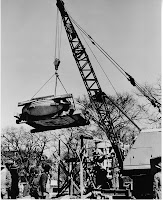Most Washington residents correctly assume that Dupont Circle
is named after the famous chemical and industrial du Pont family, but few may few
know that its central white marble fountain was not the first statuary object
to commemorate a member of that prestigious family, Admiral Samuel Francis du
Pont.
Before 1882, Dupont Circle was referred to as Pacific Circle,
a name designation instituted by city planner Charles L’Enfant. On February 25th of that year, the
U.S. Congress officially designated it as Dupont Circle, and within the
following two decades, large and lavish homes began to appear around its perimeter,
having been developed far later than Logan Circle. Dupont Circle itself was landscaped with lush
plantings, 850 ornamental trees, and exotic flowering species, and in 1884, a
bronze statue of Admiral Samuel F. Dupont was placed atop a granite base at its
center. It was sculpted by artist Launt
Thompson.
Samuel du Pont was born in 1803, and had become involved in
military affairs at the young age of 12, when he was appointed to the U.S. Navy
by President Madison. Following an
impressive military career that took place all over the world, he was appointed Rear Admiral on July 16,
1862. Toward the close of the year
several armored vessels were added to his command, mostly of the monitor
type. Being the first officer to whom
the monitors had been assigned, he carefully tested their offensive powers,
hampered by their small number of their guns and the slowness of their
fire. On April 7, 1863, du Pont led a
charge to take Charleston, South Carolina.
 |
| 1887 Hopkins Map showing path layout at the time |
His gallant effort had failed miserably, however, with
limited maneuverability in the channels, one ship sinking and five others being
disabled. Du Pont had beforehand given
an opinion that a ground force was necessary, but had been rebuffed by the Navy. His last military action seemed to tarnish
his lifelong career, and Charleston only fell on the approach of Sherman's
army. Du Pont died in Philadelphia, Pennsylvania, on June 23, 1865.
To honor him and help set the record straight, the du Pont
family erected a statue of Samuel in 1884, but today, the statue is nowhere to
be found in Washington. That's because in
1922, the du Pont family had the statue relocated to Wilmington, Delaware where
it can be found in Rockford Park.
Following its relocation, the du Pont family commissioned
Daniel Chester French to design the fountain that now stands where the statue
of Samuel once stood. Known for his
masterpiece of Lincoln in the Lincoln Memorial, French was hired to carry out
the designs of architect Henry Bacon. Incidentally,
French’s daughter then resided close by in the 2000 block of R Street. A picture taken in 1918 of the model seen here indicates
that it originally had a top fountain at the highest point that was never
incorporated into the built fountain.
Interestingly, water pipes had been laid for a potential
fountain in 1877, but had never been utilized.
The installation of the fountain itself in 1922 also met the direction
of Pierre L’Enfant’s notion in 1791 that “the center of each square will admit
of Statues, Columns, Obelisks, or any other ornament such as the different
States shall may choose to erect: to perpetuate not only the memory of such individuals
whose counsels or Military achievements were conspicuous in giving liberty and
Independence to this country.”
A popular misconception about the fountain is that the three
women are depicted on it represent the three fates from Greek mythology. Two women and one male figure actually
represent the three arts of ocean navigation: the sea, the stars and the wind. One woman is depicted holding a boat in one
hand, stroking a gull with the other, which symbolizes the sea; stars are represented
by a second female figure holding a globe. The wind is depicted by a strong male figure
draped in the wind-filled sail of a ship, holding a conch shell horn.
 The only
time the Dupont Circle fountain has been disturbed since was in 1948, when
plans commenced to temporarily remove it for the construction of the
Connecticut Avenue trolley underpass. It
was replaced shortly before its opening in November of 1949, and has remained
as a gathering spot for Dupont Circle residents ever since.
The only
time the Dupont Circle fountain has been disturbed since was in 1948, when
plans commenced to temporarily remove it for the construction of the
Connecticut Avenue trolley underpass. It
was replaced shortly before its opening in November of 1949, and has remained
as a gathering spot for Dupont Circle residents ever since.
Copyright Paul K. Williams




"but few may few know"
ReplyDeleteFirst paragraph